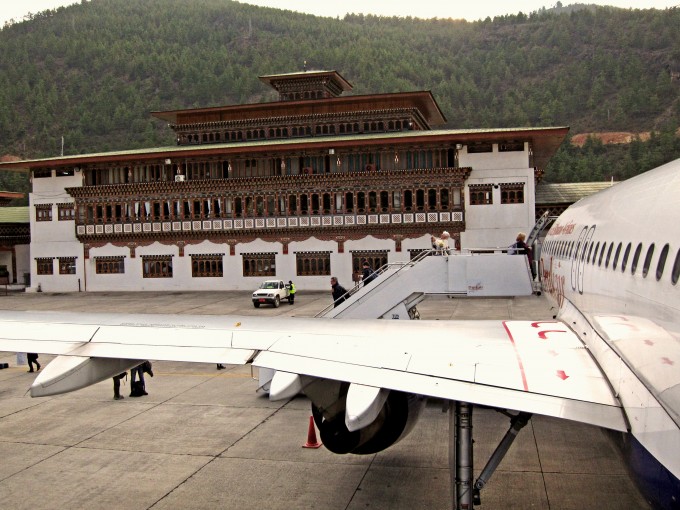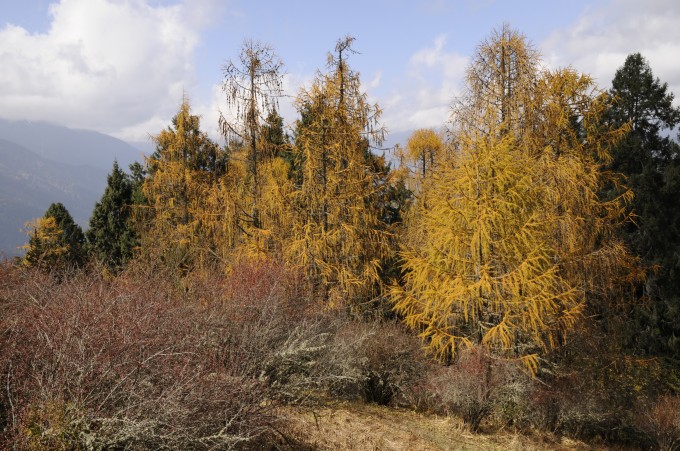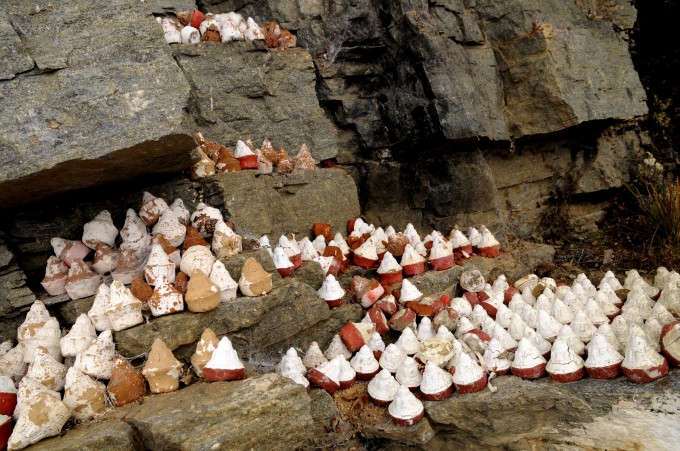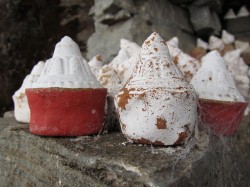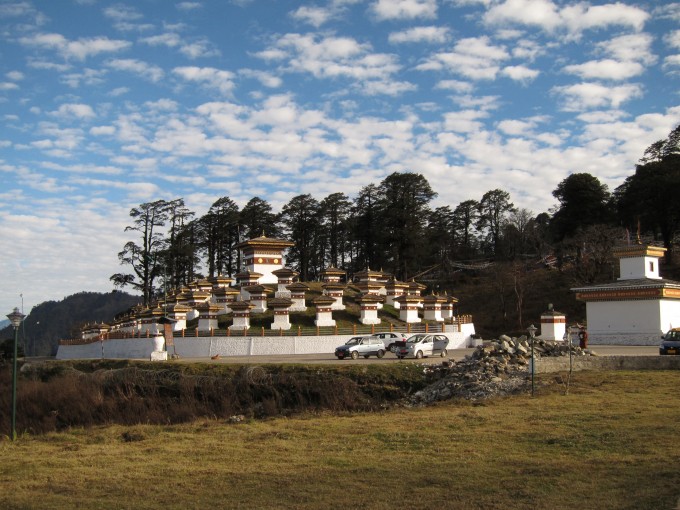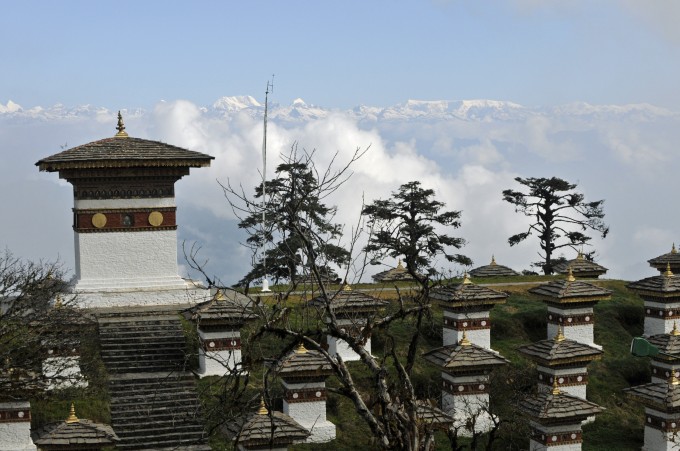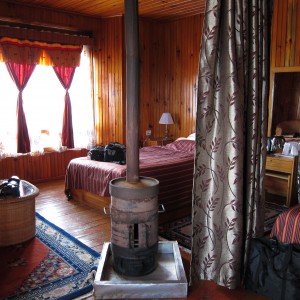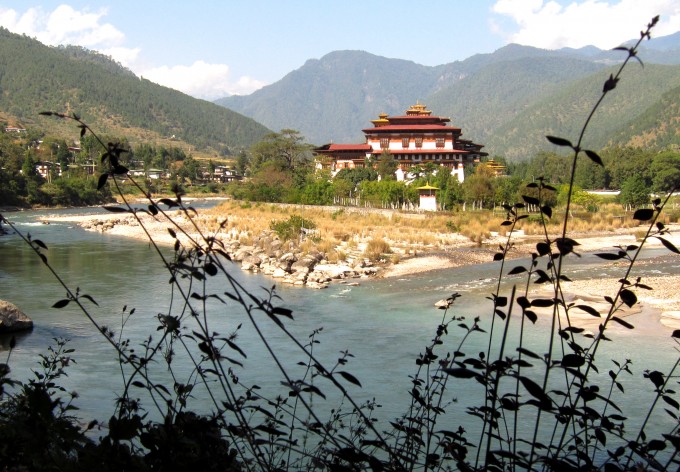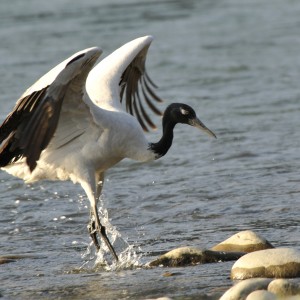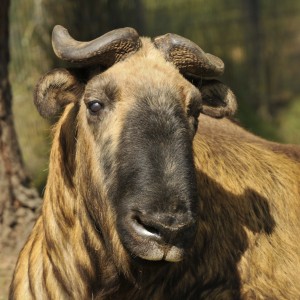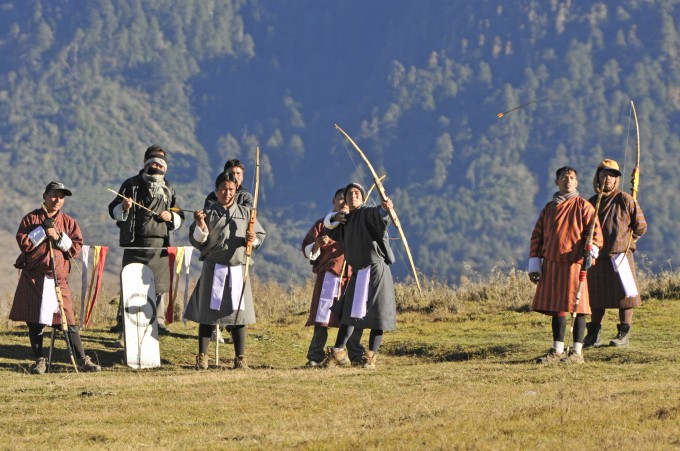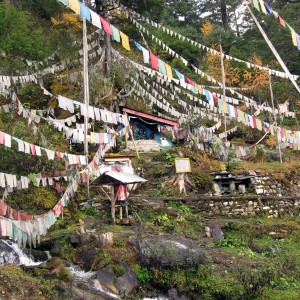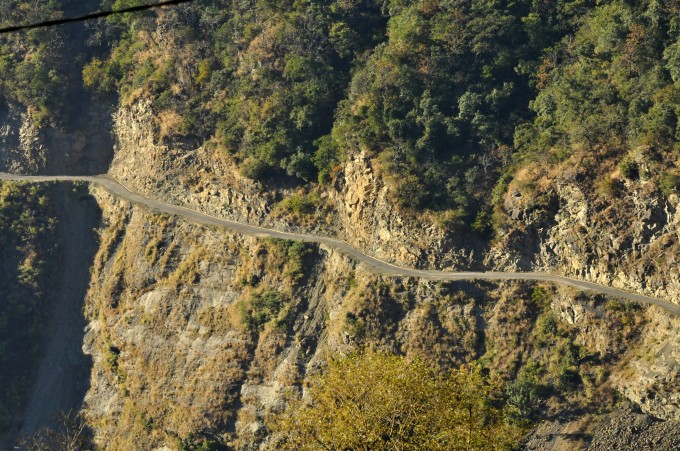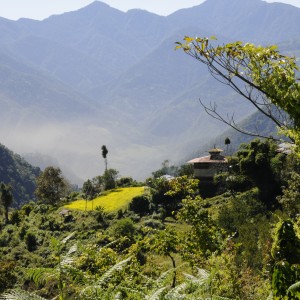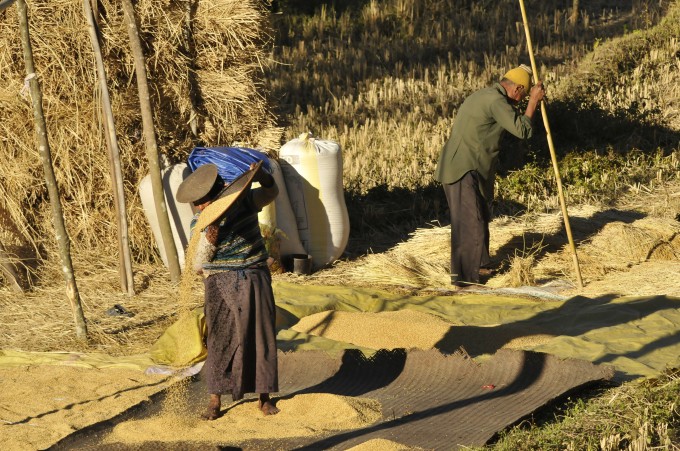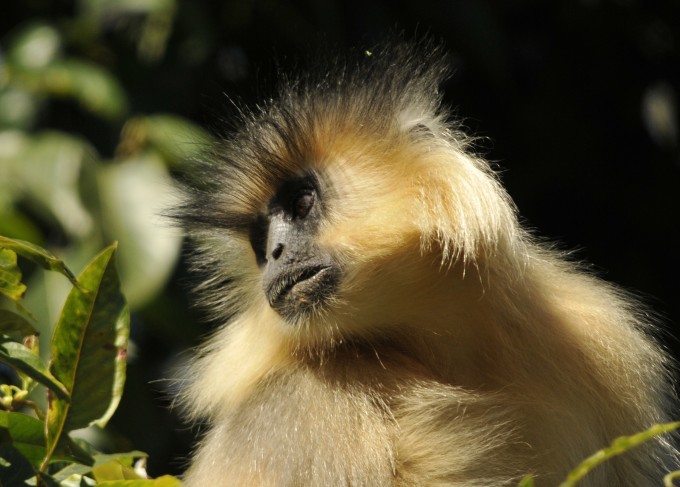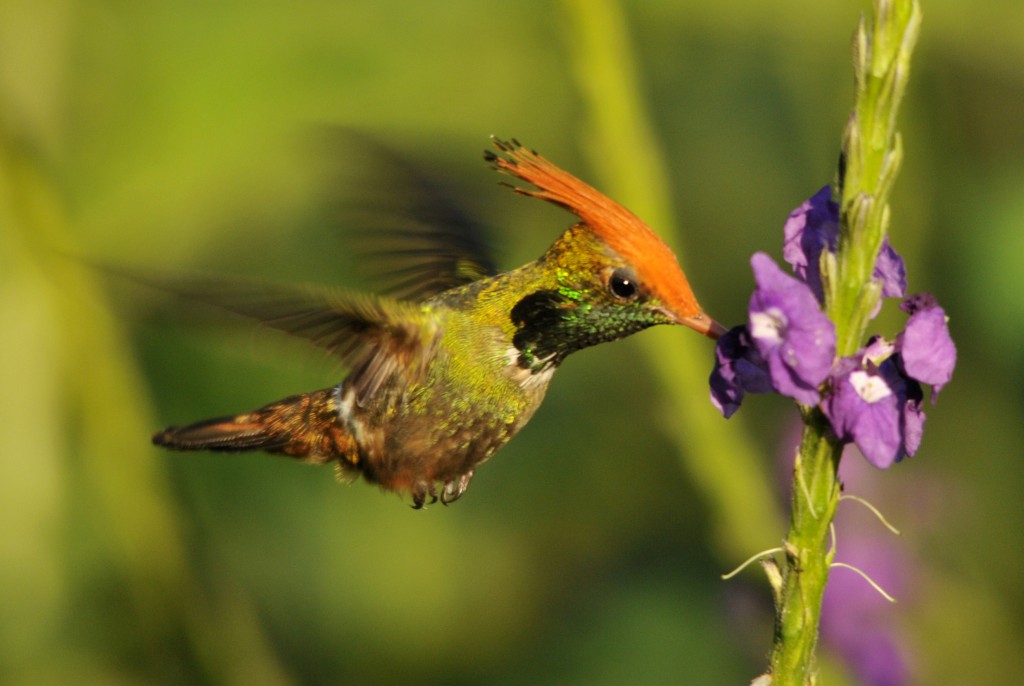PARO :
The landing in Paro airport was a bit impressive but the weather was good…After flying one hour or so above the huge white dissected range of Himalaya, the plane began to go slowly down but facing the mountains. I could not see any runaway to land but the very near slopes. I looked at the passengers, they were quiet like a flock of sheep in situation, then I decided to behave like a sheep too…
Bhutan has a Population of 750 000 inhabitants, Thimphu is the capital with 100 000 inhabitants, Paro with the international airport has only 30 000 inhabitants and stretches at 2250 m.
Bhutan has now the same problems as everywhere in the world, people think they will earn more money in town and they leave their villages loosing at the same time the traditions…
I think it was great time for me to visit this country and the last opportunity to still have an idea of the old Bhutan, which makes so many people dream….
The weather was superb when we arrived but at 4 pm the cold began to be a bit biting.
The hotel had small heaters and the room was much appreciated after that big travel.
The first morning we went to see a temple; it was a nice place that we reached by foot, following small charming paths. It was the autumn and the birch trees had taken such an exceptional color that the landscape looked quite romantic.
We returned to the hotel around 4pm, there was no current up to 6pm and then the heating was “out”…
Nothing to do than wait for the call from the restaurant. The soup was late too, depending on the current…The meal included plain rice, kind of Chinese fried vegetables, chicken in gravy, and potatoes (the best). It seemed good the first day but the problem is that it is always the same menu everywhere every day!
I asked for a beer, I got a 650ml, no choice, but the air dries the throat and a cup of tea is too small for a perfect hydration.
The road to Chelila Pass was running among high mountains covered by conifers, among them, a lot of larches had turned to be yellow due to the autumn season. We had the chance to drive at the right time before they loose their pine needles like any trees their leaves. The larches are the only conifers to get autumnal colors.
I was dreaming on this wonderful nature when I noticed in some places, groups of artificial small mushrooms with different colored hats…
After enquiring, I learnt with surprise they were made by monks with ashes of dead people mixed with clay and called tsa-tsa. In fact they are “chorten-like” and can have different top colors representing the elements such as yellow for the earth, white for the air, red for fire…these miniatures Chortens or “Stupas” are spread in some holy mountain places, they are in memory of persons which passed away and are made to help them to have a good re-birth and reach the Nirvana.
DOCHULA PASS :
As soon as we drove out of the main touristic towns, the roads are quickly in bad conditions and it seemed that we went to Dochula pass riding horseback! After a stop on the way to run after Grey Langurs, we arrived at the pass (3050m), it was cold but the view on Himalaya was really impressive and worth the trip. The Big Chorten with its 108 Stupas around had something majestic, imposing respect.
We had chosen to spend the night in the only hotel at the top and it was great. The room was very comfortable but at the same time with a “taste” of the past which we appreciated very much.
At 6 am, through our window we could assist at the sunrise on the Himalayan range, but in spite of the cold we opened the door and went out on the next terrace to enjoy this wonderful wake up of the sun on the mountains.
PUNAKHA :
lies in a sub-tropical valley, it is a small friendly town with one of the most famous Dzong (temple). The Dzong are not exclusively for the monks, they have also offices reserved for the government. At the origin they were true fortresses to protect the surroundings.
The Punakha Dzong was built at the confluence of the Pho Chhu river (male) and Mo Chu river (female) which meet to form the Puna Tsang chu River.
It is when walking along the bank that I could take pictures of the very critically endangered “White-bellied Heron”. In this part of Bhutan they remain only 3 and in all Bhutan, only around 20, in the world less than 200….
We spent 3 nights in Punakha and returning to the river I got one of my best pictures. I was looking at the bank, when I noticed a Crane. Jumping out of the car, I ran near the water, my crane was not afraid and let me shoot quietly until she flies without hurry. At the same time, I heard “voices” shouting, “don’t run, you will see many in Gangtey !
Back to the car I understood it was a Black-necked Crane which never stops here, event that the guide decided to report to the “Birds Office Book”.
My excitement had paid; I had an “exclusivity” as in Gangtey it will be impossible to approach them.
Bhutanese people like to decorate their houses which are most of the time very pretty but mainly in Punakha and around, the paintings of the walls are quite surprising. It can be seen everywhere walls with decorations such as beautiful flowers, life-sized tigers on one side of the door and on the other just an oversized phallus!
The legend comes from Drupka Kinley (1455-1529) who was fond of women and wine, he wanted to chock the clergy and from the rumor he would have hit and subdue demons with his penis.
From that legend people believe the phallus is protecting the house against deities and bad spirits.
It was in this attractive small town that I had my best meal of the country.
The reputation of Bhutan is based on ecology protection and also on the fact they don’t kill any animals. This concept left me more than skeptical when in all the restaurants they proposed a large choice of chickens and beef meat.
After enquiries, I felt very disappointed to hear that they don’t eat their local animals but import the meat from India. Meat is a common plate not only for tourists but also for all Bhutanese people.
The guide explained to us that the Bhutanese chickens are running free, people just take their eggs and referring to the cows, goats and so on… they are also having a happy life until their natural death. They live peacefully in the fields and in exchange they “offer” the milk to make butter and cream! Strange way to consider the valor of animal life when they eat those of other countries. That would say that born abroad, the animal is a “devil” one while born in Bhutan, he is a “holly” one.
Consequently of this law, people killing animals fell under the full force of the law and are severely punished!
After these considerations, the general economy of the country depends on 80% of India, but the Chinese began to appear and they should take care if they don’t want to end up like Tibet.
Bhutan is also the country of a very strange animal called “Takin”, being very difficult to find and then to approach, we decided to pay a visit to him in the Punakha zoo. I had never seen in my life such a special antilope, he is as big as a cow with a goat face and quite indifferent to people, even to me, I was offended!
On the morning we decided to go to Jigmi Jordi N.P. It is a bit far but we wanted to find the wild Takin. We were driving on a winding road among the forest since about 4 hours when the way was suddenly closed for works…That’s Bhutan! No information before, just go and come back and if not pleased it is the same…Seen like that, of course, it’s not easy to see the Takin…
The road was decorated by a quantity of long kind of ribbons with prayer flags; I was wondering how the ribbon could begin at the top of a mountain and end at the top of another mountain, the two mountains being separated by a large river? In Bhutan, the archery is the national sport, all is said!!! They fix the ribbon at an arrow, aim the bow and arrow at the facing mountain. Easy, isn’t it?
The prayer flags are made by the family in memory of a dead person, the more prayer flags, the more merit and the more chance for the defund to have a good “retreat”…
GANGTEY VALLEY :
The width of the valley makes the difference with others, it is situated in Central Bhutan at around 2900m. This place is famous because of the migration of the endangered Black-necked Cranes coming from the North in winter.
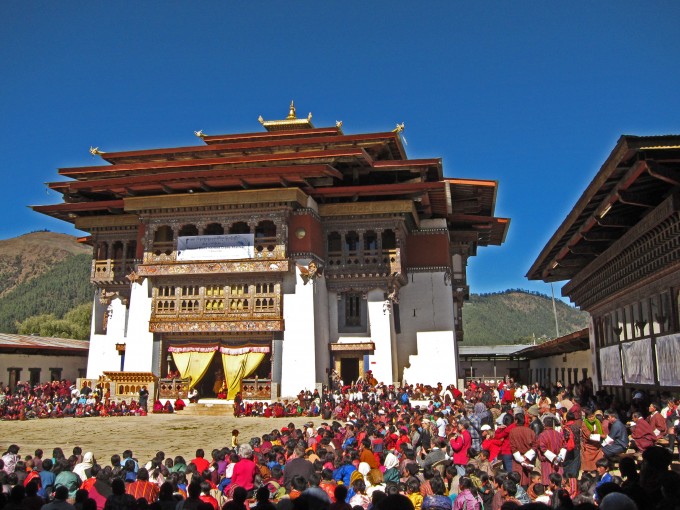 Every year in the village of Phobjikha takes place the colorful “Crane Festival” to celebrate their arrivals. It is held in the courtyard of the Dzong and gather many people.
Every year in the village of Phobjikha takes place the colorful “Crane Festival” to celebrate their arrivals. It is held in the courtyard of the Dzong and gather many people.
ZHEMGANG :
If you do want to go to Zhemgang, please don’t ask anybody about the trip, if you do, you won’t go, after on the way, you can’t change your mind and would not risk to turn back the car.
This road is among the most frightening mountain roads I have ever taken.
Trongsa to Zhemgang is about 110km, first the unpaved road is not so bad, very dusty and obstructed by a lot of big “Tata” Trucks making return trips to the under construction dam. It should offer to Bhutan 80% of its Hydro electricity against 40% now, the tourism taking the second place.
I was in hurry to pass the dam & avoid all this heavy smoke mixed with the dust released by the huge “Tata” … The fear invaded me when we had to cross trucks; the precipice was more than 800m high and very steep, no tree to stop any fall, the road was getting narrow; the curves being very tight, we had to put the wheels in alignment with the deep and my heart was upside down when I checked through the window.
I thought that after the dam, it would be easier, but not! We had the cliff on the left and always the arid deep on the right, no possibility for a bush toilet, which became a real problem. Finally, I had to stop to an isolated house suspended on the cliff and implore to spend few minutes of loneliness in their private cabin!
This done, we continued our way and were stopped after few hours of anxiety by a panel indicating the way was closed and will open at 2.30 pm. It was 2 pm, we were lucky! But it was not the same for the return, the opening of the road being at sunrise. So, it meant that the departure from Zhemgang would be at night. This road at night! I was living a nightmare and refused to think more about that…
At least, after 11 hours of quasi non stop driving, we deserved Zhemgang.
The surroundings were very picturesque and people were harvesting the paddy fields, the light was very good probably due to the altitude of 1900m.
The small town has around 2500 inhabitants and was very peaceful; we got the best hotel, noted as a 3 stars…
We had a very nice welcome at the hotel and invited to have a cup of tea in the private saloon, then the manager took us to our room.
The room was big and looked comfortable, I was very happy to see we had a good heater, as it is very cold in the night.
The bathroom was however a bit surprising, the size was about 2 square meters, no washbasin and the shower was just for Lilliputians: 2 water taps hot and cold, at one meter from the floor, the water falling directly on the floor. The shower consisted in using the saucepan provided to that effect!
To clean the floor, we had just to use the flush of the raised toilet seat as all the water was each time running direct on to the ground…Fortunately, it seems the slope of the floor had been studied by high level engineers and so the water could escape. Everything was ok…
In spite of these details, we had really a good stay at this place as everybody did his best to please us.
But why did we choose going to Zhemgang?
The purpose of our trip was overall to find and get pictures of the famous Golden Langurs, which are about 4000 in Bhutan and many of them in this district.
We had a full day to try to find them; we first saw a group hanging on the mountain but a bit too far. We were looking in the bush when the guide came toward us laughing. He said :” people here don’t see many tourists, they took your big cameras for guns and were afraid to see you shooting the golden Langurs…”
After convincing them it was not, they told him where to find them and it was a big reward to get pictures even if the sun was not exactly in the ideal position. The great problem now with Langurs is that, since humans have built bridges, the Capped Langurs leaving on the other side can cross the rivers and the males Capped Langurs are mating now with the pure golden Langurs, their genes being dominant, the pure Golden Langurs are going to disappear as a distinct species with the time…
The return to Trongsa was of course as difficult, I did not drink anything before leaving to avoid bush problem, we were now a bit hardened, but nevertheless we did enjoy our arrival safe and sound in Trongsa, happy to have survived to this unexpected dreadful long road!
